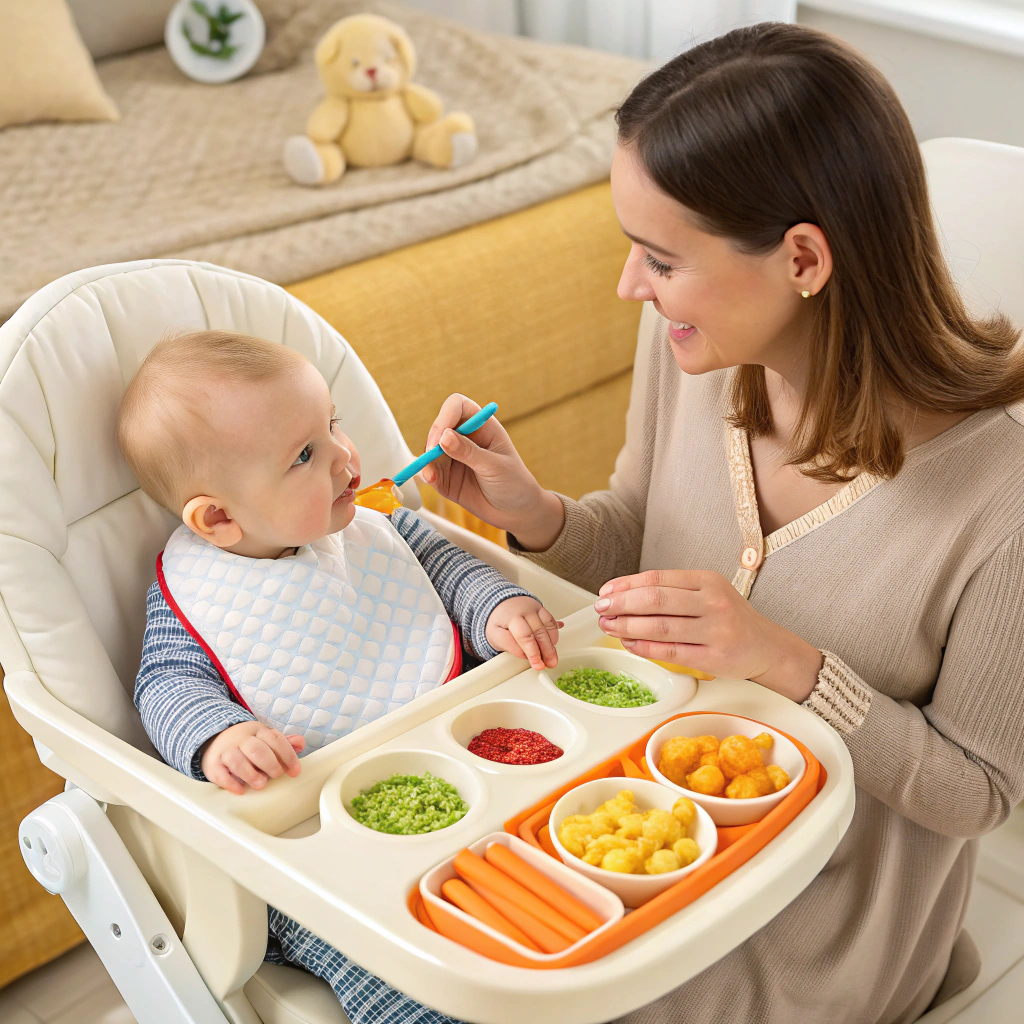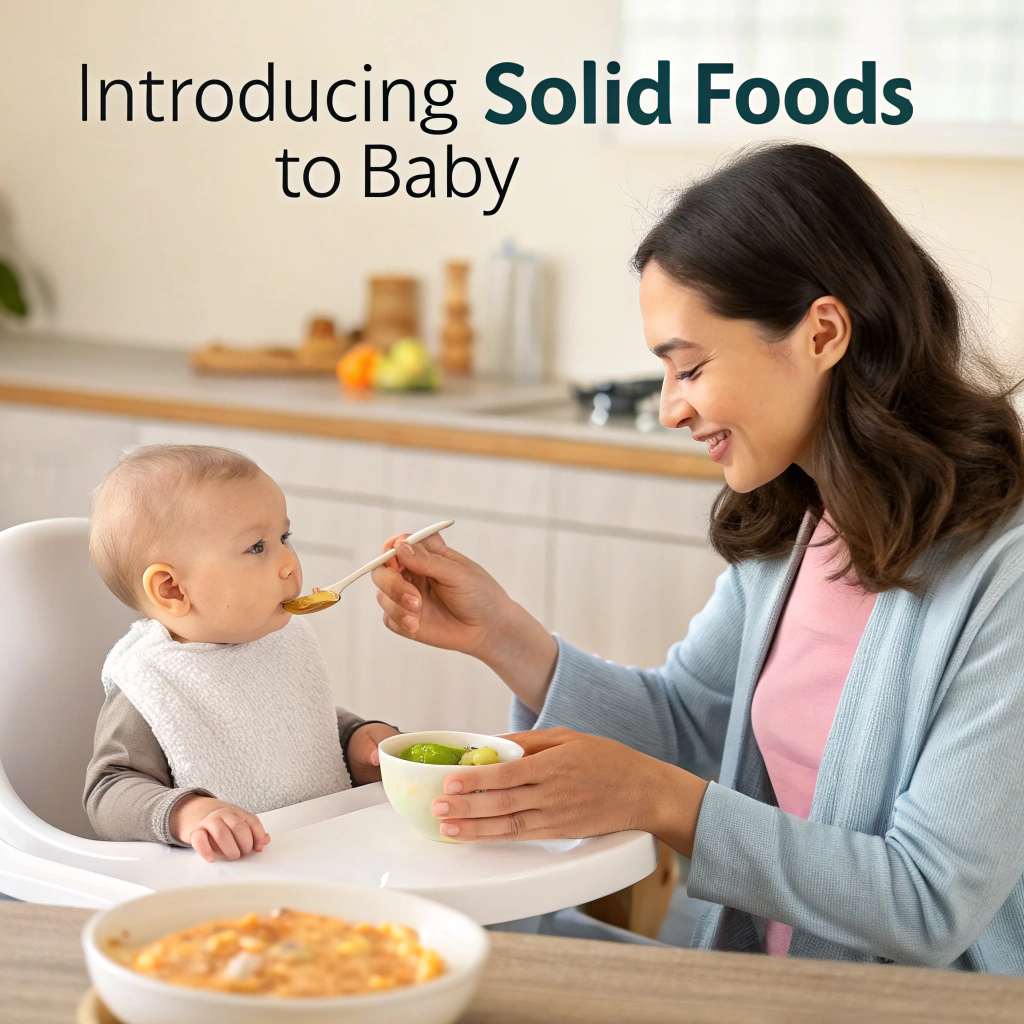Introducing solid foods to baby is an exciting milestone in their growth journey. As your little one transitions from breast milk or formula to solid foods, it’s essential to start with soft, easily digestible options like purees. Observing your baby’s readiness and response to new textures can make the experience enjoyable and smooth. In this guide, we’ll explore the best ways to introduce solid foods to baby safely and effectively.
1 . When to Start Solid Foods ?
Recommended Age for Introducing Solids
The American Academy of Pediatrics (AAP) and the World Health Organization (WHO) recommend introducing solid foods to babies around six months of age. Before this, their digestive systems are not fully developed to handle solid foods properly.
Signs Your Baby is Ready for Solid Foods
Every baby develops at their own pace, so instead of relying solely on age, look for these signs of readiness:
✅ Good head and neck control – They can sit upright without assistance.
✅ Loss of the tongue-thrust reflex –Food no longer gets pushed out of their mouth automatically.
✅ Interest in food – Watching you eat, reaching for your food, or opening their mouth when offered a spoon are all signs of curiosity.
✅ Increased hunger despite regular milk feeds – Even after full feeds, they seem unsatisfied.
If your baby doesn’t show these signs yet, wait a little longer and try again in a few weeks.
2 . Best First Foods for Babies
Nutrient-Dense Starter Foods
When introducing solid foods to baby, start with single-ingredient, easily digestible foods that provide essential nutrients like iron, zinc, and vitamins.
🥣 Iron-fortified cereals – Rice or oatmeal cereal mixed with breast milk or formula.
🥕 Pureed vegetables – Carrots, sweet potatoes, peas, and squash.
🍌 Mashed fruits – Bananas, avocados, apples, pears.
🍗 Soft meats & proteins – Well-cooked and pureed chicken, turkey, or lentils.
How to Introduce New Foods ?
- Offer one new food at a time. Wait 3–5 days before introducing another to watch for allergic reactions.
- Start with smooth purees before moving to thicker textures as your baby adjusts.
- Use a baby spoon, not a bottle, to encourage proper eating habits.
- Make mealtime fun and relaxed! Avoid force-feeding—babies learn at their own pace.
3 . How to Introduce Solid Foods to Baby ?

Step-by-Step Guide to the First Feeding
🍼 Step 1: Continue breastfeeding or formula feeding – Solid foods are only a supplement at this stage.
🥄 Step 2: Start with 1-2 teaspoons – Just 1-2 teaspoons of puree can be enough to begin.
🌿 Step 3: Use a soft-tipped spoon –Gently placing food on their lips allows them to explore the taste.
😊 Step 4: Watch for cues – Leaning forward signals interest, while turning away suggests they may not be ready.
📅 Step 5: Increase quantity gradually – Over time, offer more frequent and larger portions as your baby becomes comfortable.
Feeding Schedule for 6-12 Months
✅ 6-7 months: 1-2 meals per day (purees and mashed foods)
✅ 8-9 months: 2-3 meals per day (thicker textures and finger foods)
✅ 10-12 months: 3 meals + small snacks (soft, chopped family foods)
4 . Common Challenges & Solutions
Baby Refusing Solid Foods
🚫 Problem: Food is refused, or your baby spits it out.
✔ Solution:
- Try offering food at a different time when they’re more relaxed.
- Reintroduce the same food multiple times—babies may need 8-10 tries before accepting a new flavor.
- Eating together encourages interest and mimicking behavior.
Managing Food Allergies
- To minimize risk, introduce potential allergens (such as peanuts, eggs, and dairy) one at a time. Monitor for any reactions like rash, swelling, vomiting, or diarrhea.
- For babies with a family history of allergies, consulting a pediatrician before introducing allergens is advisable.
Transitioning to Finger Foods
By 8-10 months, small, soft pieces of food can be introduced. Safe options include:
🍞 Soft toast strips
🍎 Peeled, cooked apple slices
🧀 Small cheese cubes
🥕 Steamed veggie sticks
5 . Foods to Avoid
🚨 Honey – Can cause botulism in infants under 1 year.
🚨 Whole nuts & hard foods – Choking hazards.
🚨 Salty & sugary foods – Babies’ kidneys are not fully developed to process excess sodium.
🚨 Cow’s milk (as a drink) – Breast milk or formula remains the best choice until 12 months.
Conclusion
Starting solid foods is a gradual and exciting journey. By offering nutrient-rich purees, following your baby’s cues, and being patient with new textures, you help build a positive eating experience. Every baby is unique, so trust the process and enjoy watching your little one explore new flavors and textures!

